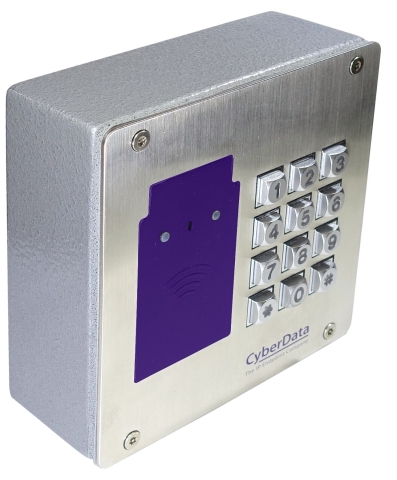by Brianna Crandall — April 9, 2018 — CyberData Corporation just announced a release of two additional devices to their new line of Secure Access Control Devices geared towards the small to medium-sized business (SMB) security market. The company designs and manufactures peripheral devices for voice over Internet protocol (VoIP) phone systems that facilitate legacy migration to VoIP, provides Internet protocol (IP) equivalents to existing analog phone devices, and delivers Unified Communications-based Application Specific Endpoints.

SIP RFID Secure Access Control Endpoint delivers a cost-effective alternative to traditional, hard-wired access control devices. Courtesy CyberData
The new SIP RFID Secure Access Control Endpoint and SIP RFID/Keypad Secure Access Control Endpoint from CyberData deliver cost-effective alternatives to traditional, hard-wired access control devices, while carrying the CyberData mark of quality when it comes to SIP-enabled Powered over Ethernet endpoints.
With the new releases, VoIP value-added resellers (VARs) and integrators can deliver a complete IP access control solution to customers using the customer’s new or existing IP PBX server. [Note: PBX (Private Branch Exchange) is the system in your company that connects individual desk extensions to external telephone lines and mobile networks. A SIP (Session Initiation Protocol)-enabled PBX is a PBX that can connect to the Internet and use the SIP protocol to make calls over the Internet.]

The SIP RFID/Keypad Secure Access Control Endpoint supports two-factor authentication. Courtesy CyberData
Access control is a critical part of a building’s security and a customer’s needs when they are deploying a secure access control system. Today’s traditional access control devices may require control panels and proprietary software/hardware, and may carry additional costs for services such as monitoring or system upgrades. CyberData’s SIP RFID Secure Access Control Endpoint and SIP RFID/Keypad Secure Access Control Endpoint provide an alternative offering for end users who are looking to integrate access control devices within an already existing VoIP infrastructure.
CyberData has implemented a high level of mutual authentication security within these radio-frequency identification (RFID) endpoints. Data between the card and the reader is encrypted using AES128, ensuring that hackers will not be able to “spy” on the card’s data being sent to the reader and duplicate that card to provide access. The SIP RFID/Keypad Secure Access Control Endpoint supports two-factor authentication.
Both devices are full-featured, with Web-based reporting and the ability to lock and unlock doors and gates. Both devices can also store up to 500 codes, including a “bad code” list that, when activated, will make a phone call and play a pre-recorded message, or broadcast a multicast message to IP notification endpoints.
Phil Lembo, president and CEO of CyberData, stated:
Arming VoIP VARs and installers and their customers with quality endpoints that integrate into a customer’s VoIP infrastructure and deliver the security features they require, while being more cost-effective than traditional devices, is our priority. The fact that these devices can operate in either stand-alone mode or as a network device is a compelling offering to customers, as it takes into account their current needs, and what may be their future needs. The value proposition, especially as it pertains to the security within the devices, is undeniable.
CyberData will demo its new line of Secure Access Control Devices at ISC West in April in Las Vegas, where the SIP RFID Keypad Access Control Endpoint will be featured in ISC West’s New Product Showcase.
To learn more about CyberData’s SIP RFID Secure Access Control Endpoint and the SIP RFID/Keypad Secure Access Control Endpoint, visit the company’s Web site.




